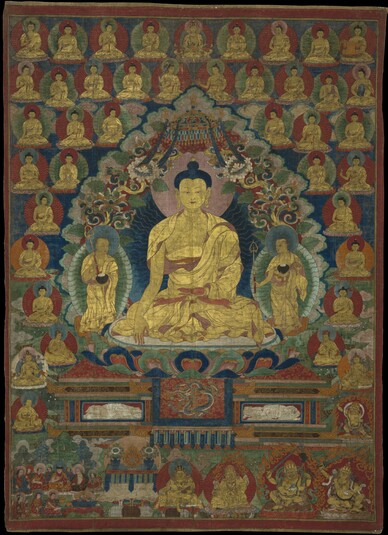
Item: Shakyamuni Buddha - with the 35 Buddhas of Confession
| Origin Location | Tibet |
|---|---|
| Date Range | 1600 - 1699 |
| Lineages | Karma (Kagyu) and Buddhist |
| Material | Ground Mineral Pigment on Cotton |
| Collection | Private |
Classification: Person
Appearance: Buddha
Gender: Male
Shakyamuni Buddha (Tibetan: sha kya tu pa, sang gye. English: the Enlightened One, Sage of the Shakya Clan) together with the two principal students, Shariputra and Maudgalyayana standing at the sides, while surrounded by the Thirty-five Confession Buddhas. The general subject of the painting is Shakyamuni Buddha and the Thirty-five Confession Buddhas. Shakyamuni is the leader of the Thirty-five Buddhas. The painting belongs to the Karma Kagyu Tradition of Tibetan Buddhism. The majority of figures are painted in gold. The date of the painting based on stylistic elements is approximately 17th to early 18th century - not later than 1732 for reasons which will be discussed below. However, based on the figures in the composition and a dated comparable work this painting can be comfortably dated to circa 1670.
On the viewer's left of the large central Shakyamuni Buddha is a standing Shariputra and on the right side is Maudgalyayana. These two are the principal students of the Buddha. In their right hands they hold the monk's staff called a kakkara. Held in the left hand is a black begging bowl.
At the top center is Amitayus Buddha. Although having a different name Amitayus is in fact a form of Amitabha Buddha. Amitabha translates into English as 'immeasurable light' while Amitayus means 'immeasurable life'. The placement of Amitayus at the top center is a decision of the artist or donor. Neither Amitayus nor Amitabha are found in any list of the Thirty-five Confession Buddhas. Amitayus is included at the top of the composition for auspiciousness but could have been substituted with the figures of Vajradhara Buddha or possibly Vajrasattva.
The painting is associated with the Karma Kagyu (Khamtsang) Tradition of Tibetan Buddhism as is evidenced by the inclusion of two Tibetan teachers wearing the unique black and red caps of the Karma Kagyu school. The two are located slightly below and behind the Two Principle Students of the Buddha. The black hat Karmapa is on the viewer's left and the red hat teacher on the viewer's right.
As for the dating of the composition, if the painting is from the 17th century then the black hat Karmapa will be the 11th, Yeshe Dorje (1675-1702) and the red hat teacher will be the 6th Gyaltsab, Norbu Zangpo (b.1660). If it is an 18th century composition then the two teachers are the 12th Karmapa, Jangchub Dorje (1703-1732), and the other is the 8th Shamarpa, Palchen Chokyi (1695-1732). These latter two teachers passed away together of smallpox while returning from China in 1732. There is a painting in the Rubin Museum collection that is comparable in line work, clouds, and colour to the painting of Shakyamuni and the Thirty-five Confession Buddhas. The painting is of the Mahasiddha Virupa and is dated confidently to between 1659 and 1671 based on an inscription on the back of the work. With that comparable and confident dating it becomes very likely that this Shakyamuni painting is depicting the 11th Karmapa and the 6th Gyaltsab and commissioned in the last quarter of the 17th century based on the life span dates of the two teachers.
The Thirty-five Confession Buddhas are arranged to the sides and below on the right and left descending half way down the composition.
In Himalayan and Tibetan art there are at least three different iconographic systems for depicting the individual Thirty-five Confession Buddhas. The principal authors of commentaries and ritual texts were Nagarjuna (not necessarily the famous Arya Nagarjuna), Sakya Pandita and Je Tsongkapa along with a number of others. The Tibetan Buddhist Resource Center (TBRC website) lists approximately sixty texts associated with the practice of the Confession Buddhas.
There are five unique iconographic characteristics in the Tsongkapa system. These characteristics can be seen with the four Buddhas that hold the hand attributes: [1] Victory Banner (middle right), [2] shirt of armor (top right), [3] sword (top left) and [4] Mount Meru in the lap (2nd row, top right). Further, [5] Nageshvara Raja Buddha (2nd row, top center) is generally depicted with a blue body and a white neck and head. He has a hood of seven snakes and the hands perform a gesture of teaching at the heart. This form of Nageshvara Raja follows the descriptions from the texts of Jowo Atisha describing the meditational deity Nageshvara Raja. The remaining thirty of the Thirty-five Buddhas display only hand gestures without any physical attributes.
Iconographic Elements of the Painting: Size, Descending Order & Hierarchy: - Shakyamuni Buddha and Two Principal Disciples above a throne - Amitayus Buddha (top center) - Thirty-five Confession Buddhas (Tsongkapa System) - Black Hat and Red Hat Karmapas - Three Lords of the World (Lokeshvara, Manjushri and Vajrapani) - Teacher Figure (lower left side. Unidentified) - Protector Deities (bottom right) - Wealth Deity (bottom center) - Donor Figures (bottom left)
Artistic Elements of the Composition: - Subject: figurative - Composition Type: floating figure - Painting Style: mixed - Menri, Khyenri and New Menri - Region: Central Tibet - Date: circa 1670 - Inscriptions: none visible - Special characteristics: hand prints on the back of the composition - Artist: unknown at this time
Jeff Watt 9-2015
Bibliography: Iconography Publications
Iconography: Main Page
Thematic Sets
Subject: Confession Buddhas (Tsongkapa System)
Shakyamuni Buddha, 释迦牟尼佛:, ཤཱཀྱ་ཐུབ་པ། Painting (Masterworks)
Subject: Canopy/Parasol in Painting
Subject: Thirty-five Confession Buddhas Main Page
Subject: Confession Buddhas, 忏悔佛, ལྟུང་བཤགས་སངས་རྒྱས་སོ་ལྔ་། (Masterworks)

